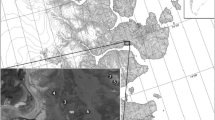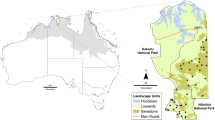Abstract
Assessing the richness of invertebrate taxa to aid conservation and management requires a better understanding of the potential sources of error. Patterns of richness for heathland spiders at the species and family levels were compared across three sampling methods, four spatial scales, and monthly intervals (for 16 months). A total of 33 families and 130 species was collected: pitfall traps collected 94% of species, sweep net, 25%, and visual search, 41%. The sampling methods produced variable results. Pitfall trap and sweep net techniques identified significant, yet contrasting spatial differences in the number of families and species at one spatial scale. Pitfall trap data reflected strong temporal variation that influenced spatial patterns in richness (across one spatial scale for families and two for species). The use of broader temporal scales introduced a potential failure to detect significant differences in the richness of ground active spiders, and this risk varied spatially. The sweep net is not recommended for this habitat, although a method that targets the foliage is required for a more complete faunal assessment. Visual searches detected no significant patterns in richness, yet given its potential and increasing use for rapid biodiversity surveys, ways to improve sampling efficiency are suggested.
Similar content being viewed by others
References
Abbott, I., Burbidge, T., Williams, M. and Van Heurck, P. (1992) Arthropod fauna of jarrah (Eucalyptus marginata) foliage in mediterranean forest of Western Australia: spatial and temporal variation in abundance, biomass, guild structure and species composition. Aust J. Ecol. 17, 263–74.
Abraham, B.J. (1983) Spatial and temporal patterns in a sagebrush steppe spider community (Arachnida, Araneae). J. Arachnol. 11, 31–50.
Addicott, J.F., Aho, J.M., Antolin, M.F., Padilla, D.K., Richardson, J.S. and Soluk, D. (1987) Ecological neighborhoods: scaling environmental patterns. Oikos 49, 340–6.
Bureau of Meteorology (1980) Climatic Survey Tasmania, Region 3, Northern. Canberra: Australian Govt. Publishing Service.
Canard, A. (1982) Utilisation comparee de quelques methodes d'echantillonnage pour l'etude de la distribution des araignees en landes. Atti Soc. Tosc. Sci. Nat. 88, 84–94.
Churchill, T.B. (1993) Effects of sampling methodology on the composition of a Tasmanian coastal heathland spider community. In Proceedings of the XIIth International Congress of Arachnology (R.J. Raven, ed.), pp. 475–81. Brisbane: Mem. Qld. Mus. 33.
Churchill, T.B. (1995) ‘Scales of Spatial and Temporal Variation in a Tasmanian Heathland Spider Community’. Unpubl. Ph.D. thesis. Griffith University, Brisbane.
Churchill, T.B. (1996) Coastal heathland spiders: spatial distribution and biogeographic significance. In Biogeography of Northeast Tasmania (R. Mesibov, ed.) pp. 151–158. Launceston: Queen Victoria Museum and Art Gallery.
Coddington, J.A., Young, L.H. and Coyle, F.A. (1996) Estimating spider species richness in a southern appalachian cove hardwood forest. J. Arachnol. 24, 111–28.
Coddington, J.A., Grisworld, C.E., Davila, D.S., Penaranda, E. and Larcher, S.F. (1991) Designing and testing sampling protocols to estimate biodiversity in tropical ecosystems. In The Unity of Evolutionary Biology: Proceedings of the Fourth International Congress of Systematic and Evolutionary Biology. (E.C. Dudley, ed.) pp. 44–60. Portland, Oregon: Dioscorides Press.
Colwell, R.K. and Coddington, J.A. (1995) Estimating terrestrial biodiversity through extrapolation. Philos. trans.-R. Soc. Lond., Biol. Sci. 345, 101–18.
Coy, R., Greenslade, P. and Rounsevell, D. (1993) A survey of invertebrates in Tasmanian rainforest. Tasmanian NRCP Technical Report No. 9, Hobart, Tasmania.
Cranston, P. and Hillman, T. (1992) Rapid assessment of biodiversity using ‘biological diversity technicians’. Aust. Biol. 5, 144–54.
Curtis, D.J. (1980) Pitfalls in spider community studies (Arachnida, Araneae). J. Arachnol. 8, 271–80.
Disney, R.H.L. (1986) Assessments using invertebrates: posing the problem. In Wildlife Conservation Evaluation. (M.B. Usher, ed.) pp. 272–93. London: Chapman and Hall.
Dobyns, J.R. (1997) Effects of sampling intensity on the collection of spider (Araneae) species and the estimation of species richness. Environ. Entomol. 26(2), 150–62.
Downes, B.J., Lake, P.S. and Schreiber, E.S.G. (1993) Spatial variation in the distribution of stream invertebrates: implications of patchiness for models of community organization. Freshw. Biol. 30, 119–32.
Edwards, R.L. (1993) Can the species richness of spiders be determined? Psyche 100, 185–208.
Hatley, C.L. and MacMahon, J.A. (1980) Spider community organization: seasonal variation and the role of vegetation architecture. Environ. Entomol. 9, 632–9.
Kirkpatrick, J.B. (1977) The Disappearing Heath - a Study of the Conservation of Coastal Heath in North and East Tasmania and the Furneaux Group. Tasmanian Conservation Trust Inc.
Kirkpatrick, J.B. (1996) The northeast in its context In Biogeography of Northeast Tasmania (R. Mesibov, ed.), Launceston: Queen Victoria Museum and Art Gallery.
Littell, R.C., Freund, R.J. and Spector, P.C. (1992) SAS ® System for Linear Models, Third Edn, Cary, NC: SAS Institute Inc.
Lubin, Y.D. (1978) Seasonal abundance and diversity of webbuilding spiders in relation to habitat structure on Barro Colorado Island, Panama. J. Arachnol. 6, 31–51.
Majer, J.D., Recher, H.F. and Postle, A.C. (1994) Comparison of arthropod species richness in eastern and western Australian canopies: a contribution to the species number debate. Mem. Qld Mus. 36(1), 121–31.
Merrett, P. (1983) Spiders collected by pitfall trapping and vacuum sampling in four stands of Dorset heathland representing different growth phases of heather. Bull. Brit. Arach. Soc. 6, 14–22.
Merrett, P. and Snazell, R. (1983) A comparison of pitfall trapping and vacuum sampling for assessing spider faunas on heathland at Ashdown Forest, south-east England. Bull. Brit. Arach. Soc. 6, 1–13.
New, T.R. (1995) An Introduction to Invertebrate Conservation Biology. Oxford: Oxford University Press.
Raven, R.J. and Gallon, J.A. (1987) The Spider Fauna of Tasmania's World Heritage Area. Tasmanian Department of Parks, Wildlife and Heritage (unpubl. report).
Robinson, M.H., Lubin, Y.D. and Robinson, B. (1974) Phenology, natural history and species diversity of web-building spiders on three transects at Wau, New Guinea. Pacific Insects 16, 118–56.
SAS Institute Inc. (1987) SAS/STATTM Guide for Personal Computers, Version 6 Edition. Cary, NC: SAS Institute Inc.
Topping, C.J. and Sunderland, K.D. (1992) Limitations to the use of pitfall traps in ecological studies exemplified by a study of spiders in a field of winter wheat. J. Appl. Ecol. 29, 485–91.
Uetz, G.W. (1975) Temporal and spatial variation in species diversity of wandering spiders (Araneae) in deciduous forest litter. Environ. Entomol. 4, 719–24.
Uetz, G.W. and Unzicker, J.D. (1976) Pitfall trapping in ecological studies of wandering spiders. J. Arachnol. 3, 101–11.
Zar, J.H. (1984) Biostatistical Analysis. New Jersey: Prentice Hall, Inc.
Author information
Authors and Affiliations
Corresponding author
Rights and permissions
About this article
Cite this article
Churchill, T.B., Arthur, J.M. Measuring Spider Richness: Effects of Different Sampling Methods and Spatial and Temporal Scales. Journal of Insect Conservation 3, 287–295 (1999). https://doi.org/10.1023/A:1009638706789
Issue Date:
DOI: https://doi.org/10.1023/A:1009638706789




